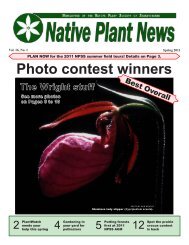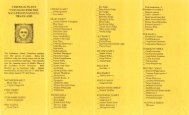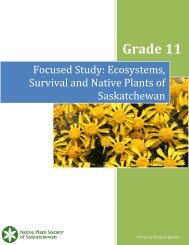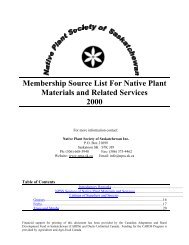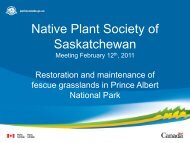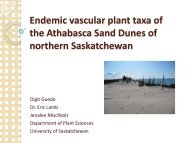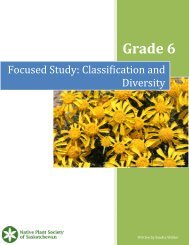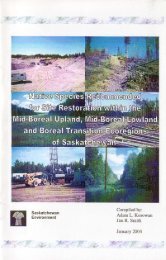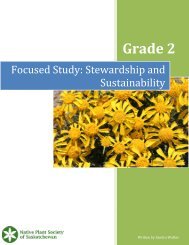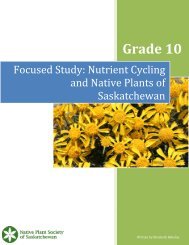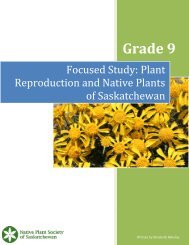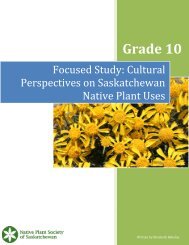Winter 2010 - Native Plant Society of Saskatchewan
Winter 2010 - Native Plant Society of Saskatchewan
Winter 2010 - Native Plant Society of Saskatchewan
Create successful ePaper yourself
Turn your PDF publications into a flip-book with our unique Google optimized e-Paper software.
Vol. 15, No. 4Weird plants<strong>Native</strong> flowerscan have areal wild sideBy Ch e t Ne u f e l dNPSS Executive DirectorIt’s no secret that I lovenative plants, and while theyare all nice in their own way,the ones I really like are theunusual ones.Most <strong>of</strong>ten, they have unusualadaptations such as beingable to trap and digest insects asour native sundews and pitcherplants do, or possessing ornateflowers like our native orchidsdo.But sometimes even common,“ordinary looking” nativeplants get a weird streak inthem. Whether it’s geneticallyinduced or the result <strong>of</strong>a fungus, local conditions orsomething totally unexplainable,sometimes nice plants doweird things.For some reason or another,<strong>2010</strong> was a very good year t<strong>of</strong>ind weird plants. Not only didI find some <strong>of</strong> my own, but Ialso had many photos <strong>of</strong> weirdplants sent to me.Continued on Pages 4 & 5photo by chet neufeldA double-bloomed gaillardia (Gaillardia aristata) withthe blossoms facing back to back.photos by Bob Godwin (left) and Paul Panton (right)(Above left) Pink western spiderwort (Tradescantiaoccidentalis). (Above right) Pale yellow spottedwestern red lily (Lilium philadelphicum var. andinum).<strong>Winter</strong> <strong>2010</strong>Celebratingforests atNPSS AGMJoin the <strong>Native</strong> <strong>Plant</strong> <strong>Society</strong> <strong>of</strong><strong>Saskatchewan</strong> in celebrating its 16thyear by attending our annual generalmeeting on Feb. 11 and 12 at Saskatoon’sTCU Place.The AGM gives people a chanceto learn about native plants andhabitats, meet like-minded peopleand have some fun! This year,we’re are also celebrating 2011 asthe International Year <strong>of</strong> Forests byfocusing on the northern half <strong>of</strong> ourprovince, an <strong>of</strong>ten-overlooked butvitally important area both for ourenvironmental, economic and socialwell-being.This year there’s an added bonusas we will be screening the winnersfrom the United Nations InternationalForest Film Festival.Submissions came in fromaround the globe from many wellknownfilmmakers and were judgedby a panel <strong>of</strong> experts. The winnerswill be shown at the premiere at theUN headquarters in New York inFebruary, after which they will besent to us. We are the only venue in<strong>Saskatchewan</strong> for this prestigiousevent. Secure your spot at thescreening by registering early as theContinued on Page 62Nursery stillin need <strong>of</strong>some care3Rare <strong>Plant</strong>6New forest7Rescue had aconservationgood <strong>2010</strong>agreement signedIs imitatingnative prairiethe way to go?1
NPSS BoardPresident:Tara Sample 777-9137Past-PresidentMichael Champion 780-6850Vice-President:John Hauer 463-5507Treasurer:Cheri Sykes 924-8007Secretary:Sarah James 787-7603Directors:Leanne Heisler 347-0447 ext. 225Jennifer Lohmeyer 787-8707Margaret Put 921-6361Kerry Hecker 836-2022Shelley Heidinger 634-9771Tara Mulhern Davidson 778-5006Executive Director:Chet Neufeld 668-3940Newsletter Editor:David Freeman 791-0047<strong>of</strong> DirectorsNPSS Address:<strong>Native</strong> <strong>Plant</strong> <strong>Society</strong> <strong>of</strong> <strong>Saskatchewan</strong>P.O. Box 21099, Saskatoon, SK S7H 5N9Phone: (306) 668-3940 Fax: (306) 668-3940E-mail: info@npss.sk.ca Website: www.npss.sk.ca<strong>Native</strong> <strong>Plant</strong> News is a quarterly publication <strong>of</strong> the <strong>Native</strong> <strong>Plant</strong><strong>Society</strong> <strong>of</strong> <strong>Saskatchewan</strong> (NPSS) and is one <strong>of</strong> the benefits <strong>of</strong>membership. Members are invited to submit articles, news,views, photographs and comments. Views expressed by theauthors are not necessarily those <strong>of</strong> the NPSS.Deadlines: Submission Publication<strong>Winter</strong> Issue: november 1 December 15Spring Issue: february 1 March 15Summer Issue: May 1 June 15Fall Issue: august 1 September 15Membership Dues (Year End November 30 th )Individual $30Family $45Student/Low Income $15Corporate $200Life $500Please contact the NPSS <strong>of</strong>fice for information about thelifetime membership instalment payment option.2The nurseryneeds your helpBy Ta r a Sa m p l eNPSS PresidentSeveral years ago I was invited to a buffalo stomp as part<strong>of</strong> a small native grassland restoration project at an elementaryschool in Regina. It was a chilly afternoon, but youwouldn’t have known that from the expressions on the faces<strong>of</strong> the students. They were far too caught up in the excitement<strong>of</strong> playing the role that bison did long ago. For many,this was likely their first genuine connection with the plantlife native to the place they call home.It was a beautiful thing to witness and something that hashappened many times since thanks to seeds collected from theRegina Plain <strong>Native</strong> Prairie Seed Nursery.I think a lot about that day as I contemplate the future <strong>of</strong>the nursery.Like many conservation initiatives, the upkeep <strong>of</strong> thenursery is largely dependent on the interest and commitment<strong>of</strong> those who volunteer to help and those who fund itsexistence. Resources like the nursery require a lot <strong>of</strong> workand money to operate, and in recent years it has fallen intodisrepair because <strong>of</strong> shortfalls <strong>of</strong> each.Last summer a group <strong>of</strong> dedicated volunteers workedhard to start bringing the nursery back to its former condition.Weeding, as many know, is a thankless job at the best<strong>of</strong> times – even in your own backyard – but these wonderfulpeople cheerfully gave up their free time to do it.Thank you for your dedication, sacrifice and support!After the dust settled at the final clean up this fall, I wasamazed at how much had been accomplished.However, there is still a great deal to be done and sadlyresources are tighter than ever.We enter 2011 facing the reality that no summer studentor paid help will be available to spend a few hours a weektaking care <strong>of</strong> the nursery as we’ve had in the past. Thiscould jeopardize the progress we’ve made so far, whichwould be a shame.If you know <strong>of</strong> any business or organization that mighthave an interest in the nursery or be able to provide this type<strong>of</strong> in-kind support, please let us know or have them contact us.And please, if you have time to spare, I urge you to comeout to a weeding bee this summer. And if you know someonethat might like to help, bring them along. Spread the word,non-members are always welcome.Alternatively, consider donating to the nursery yourself. Alittle goes a long way. Or if you know <strong>of</strong> a business, organizationor other entity who has an interest in this kind <strong>of</strong>project, have them contact Chet Neufeld to discuss sponsorshipor other donation options.Let’s hope we can keep the progress we’re making withthe Regina Plain <strong>Native</strong> Prairie Seed Nursery going so futuregenerations <strong>of</strong> children too might find that connection to theprairie I witnessed.
Rare <strong>Plant</strong> Rescue:Notes from the fieldRare <strong>Plant</strong> Rescue Field Crew on a survey during the summer.By Melissa Ra n a l l iRare <strong>Plant</strong> Rescue Coordinator,Nature <strong>Saskatchewan</strong>Considering the challenges createdby <strong>Saskatchewan</strong>’s rainy spring andsummer, Rare <strong>Plant</strong> Rescue (RPR) had avery successful <strong>2010</strong> field season.The excessive amount <strong>of</strong> rain delayedour work schedule slightly, however, thesearch and monitoring crews still found aconsiderable number <strong>of</strong> rare plants. Withour stewards’ participation, RPR wasable to search for rare plant occurrencesin Burstall, Caron, the Eyebrow Plain,the Coteau Hills, the Estevan area andthe Elbow and Dundurn sand hills. Themonitoring crew also found rare plantson some <strong>of</strong> the sites we monitored thisyear, bringing the total number <strong>of</strong> newrare plant occurrences to 128 for <strong>2010</strong>!While all the rain was a curse tomany, slender mouse-ear-cress (Transberingiabursifolia ssp. virgata) is onespecies that seems to have benefitedfrom this year’s moist conditions.Compared to 2009, slender mouse-earcresshad a considerably better showing in<strong>2010</strong>. One <strong>of</strong> our most surprising discoveriesthis summer was a new slendermouse-ear-cress population found north <strong>of</strong>Moose Jaw during the RPR search crew’straining. This was quite a find since slendermouse-ear-cress had not previouslybeen found east <strong>of</strong> Riverhurst.The world<strong>of</strong> rare plants is full <strong>of</strong> excitement!One interesting site along the South<strong>Saskatchewan</strong> River that RPR was monitoringthis year supported a large population<strong>of</strong> small-flowered sand-verbena(Tripterocalyx micranthus) that was foundin 2009. By revisiting this site severaltimes, we found that while hundreds <strong>of</strong>3photo by Melissa Ranalliseedlings were present in early June, bylate June high water levels had flooded thelow-lying plants along the shore and sandmovement had covered a portion <strong>of</strong> theindividuals growing higher on the banks.Little is known about the biology <strong>of</strong>small-flowered sand-verbena so the effect<strong>of</strong> this type <strong>of</strong> event on populationsis not known.While conducting monitoring workat the river site, we also came acrosssmooth goosefoot (Chenopodium subglabrum),a threatened species, and acollection <strong>of</strong> small-flowered sand-verbenafruits. The latter was a particularly fortunate,incidental discovery since thesefruits are easily picked up and blown bythe wind or covered by blowing sand.The RPR search crew was onceagain pleasantly surprised by a findwhile searching for western spiderwort(Tradescantia occidentalis) in DouglasProvincial Park in July. The crew founda western spiderwort plant with fourpetals instead <strong>of</strong> the typical three, andindividuals with pink flowers instead <strong>of</strong>the common purple colour (see “Weirdplants” on the cover <strong>of</strong> this issue).In the Estevan area, the buffalograss(Buchloë dactyloides) search activitieswere just as successful as the rest <strong>of</strong> thissummer’s work. The search crew foundbuffalograss on nearly every quartersection <strong>of</strong> land searched! The crew wasfortunate to see horses on several parcels<strong>of</strong> land, including one pair grazingon a patch <strong>of</strong> buffalograss – living pro<strong>of</strong>that buffalograss thrives with grazing.If you would like to know more aboutRPR, or have any comments or questionsregarding the RPR program, please feelfree to contact me any time at (306) 780-9417 or by emailing rpr@naturesask.ca.UpcomingEventsJanuary 2011<strong>Native</strong> Prairie Speaker SeriesWednesday, Jan. 19Royal <strong>Saskatchewan</strong> MuseumAuditoriumRegina, Sask.Technical: 12:15 to 12:50 p.m.Dr. Paul James: Ecological Goodsand Services.Public: 7 to 8 p.m.Dr. Howard Wheater: Water Sustainability.www.pcap-sk.orgFebruary 2011<strong>Native</strong> Prairie Restorationand Reclamation WorkshopFeb. 16 and 17Conexus Arts Centre,Jacqui Shumiatcher RoomRegina, Sask.Presented by the <strong>Saskatchewan</strong> PrairieConservation Action Plan. Registrationcloses Feb. 9. Call 306-352-0472 for moredetails.www.pcap-sk.org<strong>Native</strong> Prairie Speaker SeriesWednesday, Feb. 23University <strong>of</strong> <strong>Saskatchewan</strong>,Agriculture Building Rm. 2E17Saskatoon, Sask.Technical: 12:15 to 12:50 p.m.Renny Grilz: Status <strong>of</strong> ConservationEasements in <strong>Saskatchewan</strong> and Alberta.Public: 7 to 8 p.m.Chet Neufeld: Invasive <strong>Plant</strong>Issues in Urban Areas.www.pcap-sk.orgMarch 2011CLRA Alberta Chapter 2011 AGM andConference: Chasing the BarMarch 2 to 4Capri Hotel and Conference CentreRed Deer, Alta.Conference will explore the meaning<strong>of</strong> Chasing the Bar as it reflects on thereclamation industry.Registration deadline is Feb. 1. Formore, call 403-289-9435.www.clra.cawww. CapriCentre.comTo submit your native plantrelated event to our eventslist, send your information(including date, contact,phone number and location)to info@npss.sk.ca.
Nature can have a weird streakContinued from Page 1Many <strong>of</strong> the photos I received thisyear are <strong>of</strong> <strong>Saskatchewan</strong>’s provincialflower, the western red lily (Liliumphiladelphicum var. andinum). If any <strong>of</strong>you have read Prairie Phoenix by AnnaLeighton and Bonnie Lawrence, you’llknow that the western red lily is highlyvariable in its appearance. It can rangein colour from deep red to bright yellow,have varying amounts <strong>of</strong> spots in thethroat <strong>of</strong> the flower, and possess differentamounts and shapes <strong>of</strong> petals (technicallycalled tepals when dealing with thewestern red lily, but that’s another story).While the western red lily has itsshare <strong>of</strong> oddities, there are many othernative plants out there that also tend togo awry from time to time.Western spiderwort (Tradescantiaoccidentalis), a threatened plant listedin the Species at Risk Act, is anotherplant that can sometimes show somevariation. While conducting rare plantsurveys on a population <strong>of</strong> western spiderwort,I stumbled on a pink-floweredspecimen. Typically the flowers area deep blue-purple, but this one hadbright pink blossoms. Others have foundsimilar specimens (see front cover) inthe same area, although it is uncertainwhether or not it was the same plant.In another location, a plant was foundthat was the right colour but had fourpetals instead <strong>of</strong> the normal three (seephotos on the right). It also had an extrastamen (they usually only have six).Also this summer, I found a sunflower(Helianthus spp.) in the sand dunes<strong>of</strong> the Dundurn AESB pasture duringphoto by chet neufledThese sunflowers (Helianthus spp.) were found near Dundurn, Sask. The flower on theright has roughly half the number <strong>of</strong> petals and is lighter in colour, while the floweron the left is normal. Interestingly, both flowers were growing on the same plant!photo by Bob GodwinThis is a typical western spiderwort(Tradescantia occidentalis) specimen.the NPSS Rare <strong>Plant</strong> Survey TechniquesCourse. The flower on the right (top <strong>of</strong>page) has roughly half the number <strong>of</strong>petals and is lighter in colour, while theflower on the left is the “normal” specimen.Interestingly, both <strong>of</strong> these flowerswere growing on the same plant!photo by Jennifer RumancikThis specimen <strong>of</strong> western spiderworthas an extra petal and stamen.Some species <strong>of</strong> flowering plantsthat more commonly have a colourfulflower also have an uncommon, whitefloweredform. While at the MauriceStreet Nature Sanctuary near Nipawin,Continued on Page 5photos by Paul PantonThis lily has the typical colouring, butis missing the spots on the inner part <strong>of</strong>the tepal.photo by Candace NeufeldThis is a normal specimen <strong>of</strong> the westernred lily (Lilium philadelphicum var. andinum)– including six tepals, the right orangecolouring and the typical spotting.4photo courtesy <strong>of</strong> Nature <strong>Saskatchewan</strong>This specimen also has the typicalcolouring and spots, but sports twoextra tepals and two extra stamens.
Continued from Page 4photo by David FreemanA mountain lady’s slipper (Cypripedium montanum) in Cypress Hills InterprovincialPark was found with part <strong>of</strong> the slipper formed into a sepal.I stumbled across a white form <strong>of</strong> earlyblue violet (Viola adunca var. adunca),which, as its name suggests, is typicallyblue to purple (below).Another native plant that can havewhite flowers is blue-eyed grass (Sisyrinchiummontanum). Again, as itsname suggests, it normally has blue topurple-coloured flowers. Occasionallythough, I’ll find a washed-out or evenwhite-flowered blue-eyed grass. In fact,this year I found a white-flowered blueeyedgrass growing in my lawn. I onlyhave the typical blue-eyed grass plantedin my yard, so it will be interesting tosee what happens next year.Another wildflower that can have oddflowers is gaillardia (Gaillardia aristata).While I’ve never seen a variation in flowercolour, I’ve seen many different types <strong>of</strong>flowering heads. The photo on the covershows a double-bloomed gaillardia, withthe blossoms facing back to back. What away to increase your chances <strong>of</strong> pollination!I wonder if the seeds will be viableand, if so, whether they will produce adouble-bloom plant. It seems very unlikely,but this is typically how new speciesstart, so you never know.Another native flower that has shownhigh variation is black-eyed susan(Rudbeckia hirta). I’ve seen specimensthat have unusually large flowers (up to5 times the size) that are contorted intovarious shapes, some curling back onthemselves to form a ring. The stems onthese are also typically deformed, havingwide, ribbon-like stems (only 2 to 3mm thick but up to 5 cm wide).While on the NPSS annual summerfield tour in the Cypress Hills InterprovincialPark in July, participants found theabove mountain lady’s-slipper (Cypripediummontanum). Sometime during theformation <strong>of</strong> its flower, the slipper part <strong>of</strong>the flower and one <strong>of</strong> the sepals remained5This whiteform <strong>of</strong> earlyblue violet(Viola aduncavar. adunca)was found atthe MauriceStreet NatureSanctuarynear Nipawin.As its namesuggests, istypically blueto purple incolour, notwhite.photo byChet Neufeldjoined, preventing the slipper from fullyforming. However, it appears that not onlydid the sepal form (the green wavy edgeon the white slipper), but another fullyformed sepal grew in its place, perhapstriggered to grow by the failure to split.As you can see, native plants trulycan do weird and wonderful things.Keep your eyes open and you too mightfind one <strong>of</strong> these natural wonders.If you’ve found an odd-lookingflower, tell us about it. If you have aphoto, even better! We can post thephotos on our Facebook page and evenrun another article on them if we getenough submissions.To submit your sightings and stories,contact Chet at info@npss.sk.ca or call(306) 668-3940.
Important forestconservationagreement signedEarlier this year, 21 companies<strong>of</strong> the Forest Products Association<strong>of</strong> Canada (FPAC), and nine leadingenvironmental organizations,unveiled an unprecedented agreement– the Canadian Boreal ForestAgreement. The agreement appliesto 72 million hectares <strong>of</strong> publicforests licensed to FPAC members.The agreement, when fully implemented,will conserve significantareas <strong>of</strong> Canada’s vast boreal forest,protect threatened woodland caribouand provide a competitive marketedge for participating companies.Under the Agreement FPACmembers, who manage two-thirds<strong>of</strong> all certified forest land in Canada,commit to the highest environmentalstandards <strong>of</strong> forest managementwithin an area twice the size <strong>of</strong> Germany.Conservation groups committo global recognition and support forFPAC member efforts. The agreementcalls for the suspension <strong>of</strong> new loggingon nearly 29 million hectares <strong>of</strong>boreal forest to develop conservationplans for endangered caribou, whilemaintaining essential fibre supplies foruninterrupted mill operations.The agreement identifies explicitcommitments for both sides and setsout a plan, which includes:• The development and implementation<strong>of</strong> world-leading forest managementand harvesting practices;• The completion <strong>of</strong> joint proposalsfor networks <strong>of</strong> protected areasand the recovery <strong>of</strong> species at risk,including woodland caribou;• A full life cycle approach t<strong>of</strong>orest carbon management; and• Support for the economic future<strong>of</strong> forest communities and for therecognition <strong>of</strong> conservation achievementsin the global marketplace.Signatories have begun meetingswith provincial governments, FirstNations and communities across thecountry to seek their leadership andfull participation in advancing thegoals <strong>of</strong> the agreement.Go to the www.canadianborealforestagreement.com to read thefull press release.AGM to feature forest filmsContinued from Page 1public will also be invited to attend.In addition to the International ForestFilm Festival, we have an all-star lineup<strong>of</strong> speakers who will discuss manyimportant and interesting forest-relatedtopics. Please read the AGM agenda(attached seperately) for a timeline<strong>of</strong> events and presentations.You’llKeynote address: Nature Quest– <strong>Saskatchewan</strong>’s Boreal ForestJohn Murray will take theaudience on a journey through ourboreal forest and discuss importantfacts, such as: the world’s forestsare disappearing; <strong>Saskatchewan</strong>’sboreal forest presents a large andhealthy habitat <strong>of</strong> wildlife but itslong-term health is at risk; large,linked protected areas are a keyaspect <strong>of</strong> maintaining wildlifehabitat; and that the public has arole to play in supporting conservationinitiatives. In addition, Johnwill show examples <strong>of</strong> some <strong>of</strong> theeducation initiatives carried out inclassrooms and in the forest by theNature Quest team.John Murray is a Silvicultureconsultant with over 30 years <strong>of</strong>experience in various capacitieswithin the forestry industry in<strong>Saskatchewan</strong> and Alberta.Eco-buffersAn alternative planting design,termed an Ecological buffer(Eco-buffer) is being evaluated anddemonstrated for its ability to besuccessfully integrated into currentfarming systems, while providingdesired economic and ecologicalgoals. Eco-buffers are describedas a new shelterbelt design thatincorporates a variety <strong>of</strong> nativetrees and shrubs in a narrow, denseconfiguration that captures thesite quickly, reducing the needfor long-term weed control. Thispresentation, by Janna Lutz – anAgr<strong>of</strong>orestry Specialist with theAgr<strong>of</strong>orestry Development Centre(formerly Shelterbelt Centre), Agricultureand Agri-food Canada –6will focus on the history, research,design considerations and benefits<strong>of</strong> Eco-buffers, with examples <strong>of</strong>current demonstration projects.Endemic Vascular <strong>Plant</strong> Speciesin the Athabasca Sand Dunes <strong>of</strong>Northern <strong>Saskatchewan</strong>The Athabasca Sand Dunes<strong>of</strong> northern <strong>Saskatchewan</strong> forma dynamic landscape, housing10 endemic plant species, eachpossessing unique traits allowingfor survival amongst their habitat.Occupancy surveys were conductedfor these endemic vascular plantspecies in Athabasca Sand DunesWilderness Provincial Park duringthe summers <strong>of</strong> 2009 and <strong>2010</strong>.The objective <strong>of</strong> this survey wasto document the distribution andabundance <strong>of</strong> the endemic vascularflora <strong>of</strong> the Athabasca Sand Dunes.The presetation by Digit Guedo willbe an overview <strong>of</strong> the study areaand endemic species, as well as fieldoperations including a discussion <strong>of</strong>the range <strong>of</strong> areas surveyed, habitatclassification and sampling methods.notice that due to the popularity <strong>of</strong> ourworkshop component last year, we havedecided to hold another workshop. Thetopic this year is “Techniques for CreatingBackyard Habitat.”Ready to register? Fill out the attachedregistration form or visit theNPSS website (www.npss.sk.ca) to printout the full agenda and registration.16th annual NPSS AGM speakersGuedo is a graduate student inthe Department <strong>of</strong> <strong>Plant</strong> Sciences atthe University <strong>of</strong> <strong>Saskatchewan</strong>.Restoration and Maintenance<strong>of</strong> Fescue Grasslands in PrinceAlbert National ParkJeff Weir, the Prince AlbertNational Park Fire/Vegetation Specialist,will talk about key issues thatthreaten the long term maintenance<strong>of</strong> fescue grasslands in Prince AlbertNational Park. He will describe howthe park plans to address these issuesand will provide real examples <strong>of</strong>activities that are currently underway.A Sensitive Slope: Forest RecoveryAfter Fire in a Changing ClimateForests are composed <strong>of</strong> longlivedplants capable <strong>of</strong> toleratinghigh levels <strong>of</strong> environmental stress.As a result, forests may show a lot<strong>of</strong> inertia in responding to changingenvironmental conditions, such asthose brought on by recent climatechange. Instead <strong>of</strong> gradual change,resilience theory predicts that weshould see punctuated changes inforest communities that are triggeredby disturbance. In this talk, Dr.Jill Johnstone will present resultsfrom a recent fire near Whitehorse,Yukon (the 1998 Fox Lake fire) andexamine patterns <strong>of</strong> forest recoveryin light <strong>of</strong> resilience theory. Dr.Johnstone is an assistant pr<strong>of</strong>essor atthe University <strong>of</strong> <strong>Saskatchewan</strong>.Field Guide to the Ecosites <strong>of</strong> <strong>Saskatchewan</strong>’sProvincial ForestsThe ecosystems <strong>of</strong> <strong>Saskatchewan</strong>’sprovincial forestshave recently been classified anddescribed in a field guide that coversthe province’s four ecozones: TaigaShield, Boreal Shield, Boreal Plain,and Prairie. The ecosystems arerepresented at the site level with 81ecosites. Each ecosite is describedon a fact sheet that provides a summary<strong>of</strong> the site attributes includingcharacteristic vegetation, speciesrichness, soil conditions, and muchmore. The classification is the result<strong>of</strong> almost 10 years <strong>of</strong> field surveysand scientific analysis. The presentationwill be provided by MichaelMcLaughlan, R.P.F., a registeredpr<strong>of</strong>essional forester and a forestecologist with the <strong>Saskatchewan</strong>Ministry <strong>of</strong> Environment.
<strong>Native</strong> prairie – worth imitating?A look intonative vs.introducedgrass speciesBy Mi c h a e l Sc h e l l e n b e r gSPARC Research ScientistIf you were to imitate native prairie,what elements would you need forsuccessfully-functioning grassland?First, when you think <strong>of</strong> nativeprairie, two things immediately jumpto mind: grass and biodiversity. Withregards to grass, the first issue is whichgrasses do you use?Within agricultural systems, individualshave argued introduced speciesare more productive but more recentthinking is questioning this assumption.Many <strong>of</strong> the comparisons have beenmade between newly-seeded introducedspecies and undisturbed prairie, which isnot a true comparison.In order to be a true comparison,access to resources should be the same.But in this case, for example, the soilenvironment is not equal. New seedlings(typically introduced species) areusually established on recently disturbedsoils with limited competition in theroot zone that allows the seedlings freeaccess to resources such as nitrogen andwater. Well established undisturbed nativeprairie, however, <strong>of</strong>ten has limitednitrogen and water due to the fact rootsystems <strong>of</strong> established plants have fullyexplored the soil and captured much <strong>of</strong>the free resources.The second item is the number <strong>of</strong>species.When people consider seedingplants, be they for annual crop production,lawns or forage, they tend to seeda single plant species. The question iswhether this is appropriate or just thesimplest choice?Experts have argued the benefits <strong>of</strong>multiple species for increased production.Also, an increased number <strong>of</strong> plantspecies will provide a larger number <strong>of</strong>photo by Michael schellenbergThese long-term multi-species native grass test plots at the semi-arid PrairieAgriculture Research Centre in Swift Current will give researchers insight into thenuances <strong>of</strong> prairie dynamics.forage choices for the foraging animalto meet its nutritional needs.In fact, if the combination is correctyou could get both good productionand nutrition. Grass/legume combinationshave been shown to provide bothan increase in plant material as wellas increasing nutritive quality at somepoint during the growing season. At theSemiarid Prairie Agricultural ResearchCentre (SPARC) we have shown bycombining a native forage shrub with alegume that you get an increase in plantmaterial equal or greater than whengrown alone.But is there an advantage to havingcombinations <strong>of</strong> species <strong>of</strong> the sameplant type (ie. grasses or legumes orshrubs)?One would expect there to be anadvantage to a mixture <strong>of</strong> plant speciesif they rooted at different depths, andmatured at different rates. The plantswithin these mixtures would potentiallyaccess resources, like water, differentlyand potentially decrease the fight for theresource between the plant species.In 2001 at SPARC we set out to seeif this is what would happen. <strong>Native</strong> andintroduced grass species were seeded inmixtures <strong>of</strong> introduced or native grassesand as single species. The species usedwere crested wheatgrass (Agropyron7cristatum), Russian wildrye (Psathyrostachysjunceus), green needle grass(Nasella viridula), western wheatgrass(Pascopyrum smithii) and switch grass(Panicum virgatum).After 4 years <strong>of</strong> growth and datacollection we noted a couple things.The first was that native species, overthe four year period, produced statisticallythe same biomass as the introducedspecies. This is contrary to popularthought. Secondly, the mixture producedsignificantly more plant material thansingle species.These grass species differ in maturityrates and root depth. Additional workby a graduate student has determineddifferent micro-organism communitiesassociated with grasses which differaccording to depth and over time.So, there is a benefit to having differingspecies <strong>of</strong> the same plant grouping;in this example, grasses seeded as mixturesinstead <strong>of</strong> as single species. Alsoin this case, the simpler seeding mixdid not provide an advantage for plantmaterial production. Benefits <strong>of</strong> diversifyingplant species within a plant typeand with additional plant types suchas legumes or shrubs can be realized.Ongoing work at SPARC is identifyingcharacteristics <strong>of</strong> native prairie worthimitating.
Did you know?The National Seed Herbariumhas found a home in SaskatoonCorporate Members and Partnersphoto courtesy <strong>of</strong> the National seed HerbariumAn example <strong>of</strong> one <strong>of</strong> the many specimens in the collection.The National Seed Herbarium is a well-organized, comprehensivecollection with representative seeds from aroundthe globe. And it now resides in Saskatoon.On Jan. 17, 2008, the completion <strong>of</strong> the move <strong>of</strong> theNational Seed Herbarium (NSH) from Ottawa to its newhome at the Seed Science and Technology Section (SSTS)<strong>of</strong> the Canadian Food Inspection Agency (CFIA) Saskatoonlaboratory was celebrated.The NSH is the largest seed taxonomic herbarium in Canadaand an essential resource for Canadian seed analysts, plant healthinspectors and even archaeologists to confirm plant species byseed identifications. Herbarium specimens are used to compareto unknown seeds and to represent a verification standard.The task <strong>of</strong> managing the NSH, its holdings and new accessions,is now in the hands <strong>of</strong> the NSH curator, Dr. RuojingWang, and the herbarium technologist, Jennifer Neudorf.The National Seed Herbarium is believed to have startedin the early 1920’s as a part <strong>of</strong> the Federal Department <strong>of</strong>Agriculture, but the exact date is not known. Seed specimenshave been added steadily over the years. Many <strong>of</strong> the newspecimens have come from large botanical gardens withBerlin, Germany being a major source.The current holdings <strong>of</strong> the Herbarium are approximately20,000 specimens <strong>of</strong> 14,000 unique species, representing 239families and 3,279 genera. The oldest specimen is an 1869sample <strong>of</strong> Larkspur seed (Delphinium bicolor) received in1905 from Utah.The CFIA, Saskatoon laboratory, is excited to be the caretaker<strong>of</strong> this important Canadian resource, and looks forwardto enhancing the collection and increasing the knowledge <strong>of</strong>seed morphology and biology to better meet the regulatoryneeds for seeds and pest plant species. To learn more aboutthe NSH, email SSTS@inspection.gc.ca.RETURN UNDELIVERABLE CANADIAN ADDRESSES TO:<strong>Native</strong> <strong>Plant</strong> <strong>Society</strong> <strong>of</strong> <strong>Saskatchewan</strong> Inc.P.O. Box 21099Saskatoon, SK S7H 5N9TO:Canada Publication Mail Agreement #400359098



